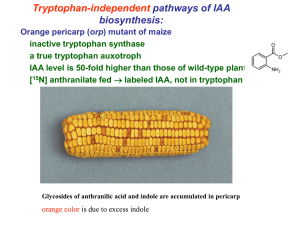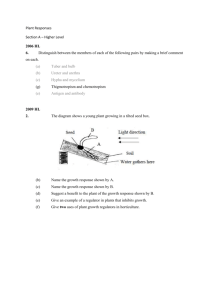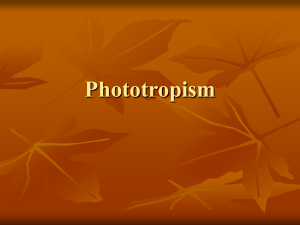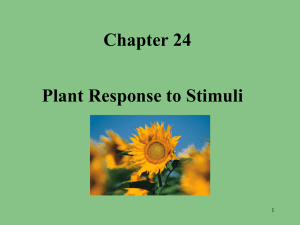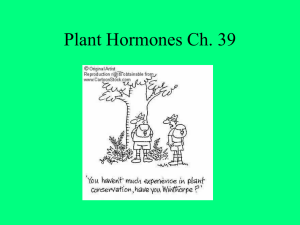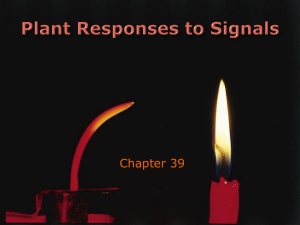Plant responses * tropisms, growth regulators
advertisement
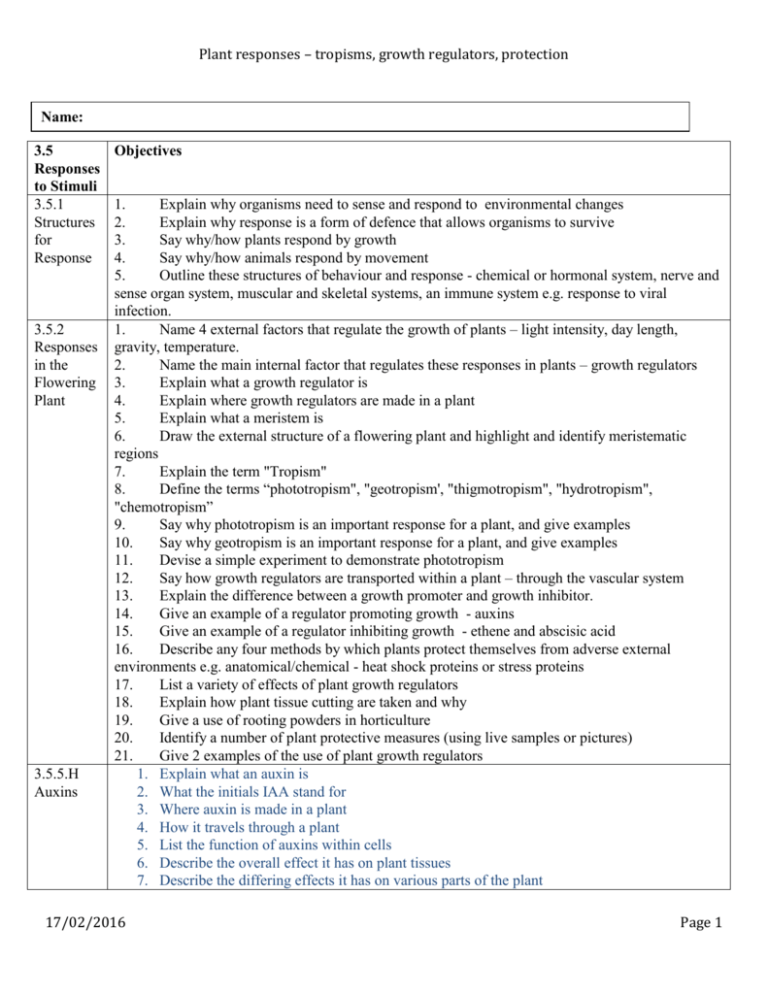
Plant responses – tropisms, growth regulators, protection Name: 3.5 Responses to Stimuli 3.5.1 Structures for Response 3.5.2 Responses in the Flowering Plant 3.5.5.H Auxins Objectives 1. Explain why organisms need to sense and respond to environmental changes 2. Explain why response is a form of defence that allows organisms to survive 3. Say why/how plants respond by growth 4. Say why/how animals respond by movement 5. Outline these structures of behaviour and response - chemical or hormonal system, nerve and sense organ system, muscular and skeletal systems, an immune system e.g. response to viral infection. 1. Name 4 external factors that regulate the growth of plants – light intensity, day length, gravity, temperature. 2. Name the main internal factor that regulates these responses in plants – growth regulators 3. Explain what a growth regulator is 4. Explain where growth regulators are made in a plant 5. Explain what a meristem is 6. Draw the external structure of a flowering plant and highlight and identify meristematic regions 7. Explain the term "Tropism" 8. Define the terms “phototropism", "geotropism', "thigmotropism", "hydrotropism", "chemotropism” 9. Say why phototropism is an important response for a plant, and give examples 10. Say why geotropism is an important response for a plant, and give examples 11. Devise a simple experiment to demonstrate phototropism 12. Say how growth regulators are transported within a plant – through the vascular system 13. Explain the difference between a growth promoter and growth inhibitor. 14. Give an example of a regulator promoting growth - auxins 15. Give an example of a regulator inhibiting growth - ethene and abscisic acid 16. Describe any four methods by which plants protect themselves from adverse external environments e.g. anatomical/chemical - heat shock proteins or stress proteins 17. List a variety of effects of plant growth regulators 18. Explain how plant tissue cutting are taken and why 19. Give a use of rooting powders in horticulture 20. Identify a number of plant protective measures (using live samples or pictures) 21. Give 2 examples of the use of plant growth regulators 1. Explain what an auxin is 2. What the initials IAA stand for 3. Where auxin is made in a plant 4. How it travels through a plant 5. List the function of auxins within cells 6. Describe the overall effect it has on plant tissues 7. Describe the differing effects it has on various parts of the plant 17/02/2016 Page 1 Plant responses – tropisms, growth regulators, protection 3.5.6 Plant growth regulators 8. Explain the term apical dominance 9. Explain the term apical dormancy 10. Explain the term fruit development 11. Explain the term stimulus 12. Explain the term elongate 13. Explain the term differentiate 14. Explain what a coleoptile is 1. Explain the mechanism of plant response to any one external stimulus. Mandatory Experiment - Investigate the effect of IAA growth regulator on plant tissue. Sensitivity is the ability to detect change and to respond to it. Animal stimuli involve the sense organs and responses include movement, production of enzymes or hormones and feeding. Plant stimuli include light, temperature and gravity and responses include growth, flowering and production of enzymes and hormones. Animals tend to adapt to new situations by modifying their behaviour and plants by modifying their growth. External factors that regulate the growth of plants are light intensity, day length, gravity and temperature. Internal factors are the production of growth regulators. A plant growth regulator is a chemical that controls the growth of plants. Produced in the meristematic regions an transported through the vascular system (phloem). Some growth regulators promote growth e.g auxin. Others inhibit growth e.g. ethene and abscisic acid. AUXINS e.g. IAA (indole acetic acid) Productions sites: normally produced in root and shoot tips (meristems), young leaves, developing seeds, buds and in the tips of coleoptiles (young shoots) Functions: Stem Cell elongation Stimulate cell elongation in stem. Auxin loosens the cellulose fibres in plant cell walls and this allows the cells to elongate. Apical dominance Causes apical dominance (inhibits side branching). If apical bud removed then side buds grow (bushier plant). Phototropism Leaves 17/02/2016 Prevents leaf fall. Page 2 Plant responses – tropisms, growth regulators, protection Fruit Fruit formation IAA is made in developing seeds. It stimulates food to form in fruit which surrounds the seed(s). Inhibits fruit drop. May cause parthenocarpic fruit (If IAA is artificially applied to flowers before pollination and fertilisation occurs, the ovary enlarges and forms seedless fruit – parthenocarpic fruit e.g. seedless grapes, oranges and tomatoes. Root: Stimulates cell elongation in root. Causes rapid root development in cuttings (adventitious roots). At low concs. IAA causes roots to grow. IAA can be applied artificially to stimulate rooting of cuttings. However artificial synthetic growth promoters e.g. NAA are more efficient at this process. At max. conc. of auxin, 1 ppm for stem growth inhibits root growth . At max. conc. of auxin, 10-4 ppm for root growth inhibits stem growth. Uses of commercially prepared plant regulators (know two) Fruit development Seedless fruit: if plants are sprayed with auxins before pollination it tricks the flowers into forming fruits. Ripening of fruit: “Green” fruit allows for transport (often smothered in CO2 gas). Ethene is then used to ripen fruit e.g. tomatoes and citrus fruits. Rooting powders Auxins are used to stimulate plant cuttings to grow quicker. Identical to parent (clone). Fruit harvesting Spraying with auxins prevents fruit drop. This allows the fruit to grow larger. When fruit is fully ripe the crop is sprayed with abscisic acid for harvesting. Tissue culturing Pieces of plant material are grown to form new plants. If a piece of plant tissues is grown in a high conc. of auxin, it will develop a callus. By adding different concs. of auxin the callus can be stimulated to form roots, shoots or entire plants. Growth inhibitors ABSCISIC ACID (produced in leaves, stems and root caps) Causes bud and seed dormancy. Inhibits growth or premature seed germination in late winter/early spring. If sprayed on plants before transporting it reduces damage. Plants are more resistant to damage if dormant. ETHENE (a gas produced by stem nodes, ripe fruits and decaying leaves). Ripening of fruit - quickens fruit ripening by stimulating respiration rate within the fruit e.g. bananas picked green and sprayed with ethene when needed for sale. Also, fruits produce it as they ripen. 17/02/2016 Page 3 Plant responses – tropisms, growth regulators, protection Inhibits stem growth, particularly during periods of stress e.g. drought. Contributes to the breaking of dormancy. Abscission of leaves, flowers and fruits. Auxin is produced by young leaves so leaves do not fall, but auxin production is slowed in old leaves so they produce more ethene, due to longer nights, so leaves fall (usually autumn in Ireland). Tropism = growth response of a plant to an external stimulus. Tropisms ensure a plant is positioned most favourably for its growth. Stems are positively phototrophic and negatively geotrophic and roots are vice versa. Phototropism: growth response of a plant to light (leaves held up to more light for photosynthesis) Chemotropism: growth response of a plant to chemicals e.g. (1) pollen tubes grow toward chemicals produced within the ovary of the flower (2) roots grow towards minerals. Thigmotropism: growth response of a plant to touch e.g. shoot tips and tendrils grow along objects on which they can become attached e.g. ivy, peas, climbing roses to keep leaves upright. Geotropism: growth response of a plant to gravity. Roots grow down into soil for water and minerals. Hydrotropism: growth response of a plant to water. Expt.: Phototropism - shoebox and cress. Mechanism of a plant response to light (i.e. phototropism) Auxin and cell elongation. Auxin loosens cell walls, which allows them to expand. It is thought that auxin stimulates the activation of enzymes in the cell wall which break the bonds between the cellulose strands. Role of auxin (IAA) in phototropism IAA is produced in growth tips of stem. If stem is exposed to unilateral light IAA will diffuse down the shaded side. The higher conc. of IAA in the cells on the shaded side causes them to elongate more than the cells on the bright side. Hence the stem bends towards the light. 17/02/2016 Page 4 Plant responses – tropisms, growth regulators, protection Plant adaptations for protection (anatomical or chemical adaptation – know four) Plants must protect themselves from loss of water, overheating, being infected by microorganisms and being eaten by herbivores. Anatomical protective features Epidermis/bark/cuticle– prevent entry of pathogens and reduce water loss Thorns, spines, needles, stinging hairs (thistles, cacti, blackberry bushes, nettles) – protect against predators Chemical protective features Heat shock proteins produced by plant when temps. rise above 40oC surround other proteins, especially enzymes, and help them maintain their shape. Plants can produce stress proteins which help protect against an infecting microorganism. Some plants produce poisonous chemicals e.g. oak produce tannins in their leaves to protect them against caterpillars. Rhubarb leaves contain oxalic acid which has a bitter taste and is fatal in large doses. Section A Plant Responses 2006 HL 6. Distinguish between the members of each of the following pairs by making a brief comment on each. (g) Thigmotropism and chemotropism …………………………………………………………… ………………………………………………………………………………………………… 2009 HL 2. (b) (c) (d) 17/02/2016 The diagram shows a young plant growing in a tilted seed box. Name the growth response shown by A. ___________________________________________ Name the growth response shown by B. ___________________________________________ Suggest a benefit to the plant of the growth response shown by B. Page 5 Plant responses – tropisms, growth regulators, protection (e) (f) ____________________________________________________________________________ ____________________________________________________________________________ Give an example of a regulator in plants that inhibits growth. ___________________________ Give two uses of plant growth regulators in horticulture. 1. __________________________________________________________________________ 2. __________________________________________________________________________ 2004 OL 1. (c) Phototropism is the growth response of a plant to ………………………………….……………. 2009 OL 6. (a) (b) (c) (d) (e) Give the term used for the growth response shown by the plant shoot in the diagram above. ____________________________________________________________________________ Why is this growth response of benefit to plants? ____________________________________________________________________________ Name the group of substances that controls such responses. ____________________________________________________________________________ Name the tissue through which the substances named in (c) are transported in the plant. ____________________________________________________________________________ Name another growth response found in plants. ____________________________________________________________________________ 2011 OL 4. Indicate whether each of the following statements is true (T) or false (F) by drawing a circle around T or F in each case. Example: The liver produces bile (b) 17/02/2016 The growth response of a plant to light is called phototropism. T T F F Page 6 Plant responses – tropisms, growth regulators, protection T F Section B Plant Responses Higher Level SEC Sample Paper HL 9. (a) State a location in a flowering plant where a growth regulator is secreted …………………………………………………………………………………………………….. Give an example of the use of a synthetic growth regulator ……………………………………………………………………..……………………………… (b) The diagram shows apparatus that may be used to investigate the effect of the growth regulator IAA. Name A. ....................................................................................................................... What is the purpose of A in this experiment? ............................................................................. How would you make up solutions of different concentrations from a stock solution of IAA …………………………………………………………………………………………………… …………………………………………………………………………………………………… …………………………………………………………………………………………………… …………………………………………………………………………………………………… …………………………………………………………………………………………………… …………………………………………………………………………………………………… …………………………………………………………………………………………………… …………………………………………………………………………………………………… After preparation the dishes are placed standing on their edges for a number of days. What is the reason for this? …………………………………………………………………………………… ………………….………………………………………………………………………………… Describe the results that you would expect in this experiment. ..................................................... …………………………………………………………………………………………………… …………………………………………………………………………………………………… 2006 HL 7. (b) In the case of each of the following state: 1. An investigation in which you used it, 2. The precise purpose for its use in the investigation that you have indicated. (i) IAA 17/02/2016 Page 7 Plant responses – tropisms, growth regulators, protection 1 ……….……………………………………………………………………………………… 2 .……………………………………………………………………………………………… ………………………………………………………………………………………………… ………………………………………………………………………………………………… 2008 HL 8. Growth regulators in plants can promote growth or inhibit it. (a) Give an example of each of the following: (i) A growth regulator that promotes growth ……………………………………………… (ii) A growth regulator that inhibits growth ………………………………………………… (b) In the course of your studies you investigated the effect of a growth regulator on plant tissue. Answer the following questions in relation to that investigation. (i) Name the plant that you used ..………………………………………………………… (ii) Describe how you carried out the investigation …………………………………………… ……………………………………………………………………………………………… ……………………………………………………………………………………………… ……………………………………………………………………………………………… ……………………………………………………………………………………………… ……………………………………………………………………………………………… ……………………………………………………………………………………………… ……………………………………………………………………………………………… ……………………………………………………………………………………………… ……………………………………………………………………………………………… ……………………………………………………………………………………………… ……………………………………………………………………………………………… ……………………………………………………………………………………………… ……………………………………………………………………………………………… ……………………………………………………………………………………………… ……………………………………………………………………………………………… ……………………………………………………………………………………………… ……………………………………………………………………………………………… ……………………………………………………………………………………………… (iii) (iv) 2010 HL 9. (a) (i) (ii) 17/02/2016 Give a safety precaution that you took while carrying out the investigation …………….... ……………………………………………………………………………………………… ……………………………………………………………………………………………… ……………………………………………………………………………………………… State the results that you obtained …………………………………………………………. ……………………………………………………………………………………………… ……………………………………………………………………………………………… ……………………………………………………………………………………………… ……………………………………………………………………………………………… What is a tropism? ....................................……………………………………………………. ………………………………………………………………………………………………… What is a plant growth regulator? ……………………………………………………………. ………………………………………………………………………………………………… Page 8 Plant responses – tropisms, growth regulators, protection (b) 2012 HL 7. (b) 2011 OL 8. (b) Answer the following in relation to an investigation that you carried out into the effect of the growth regulator IAA on plant tissue. (i) What plant tissue did you use? ………………………………………………………………... (ii) Describe how you carried out the investigation. …………………………………………………………………………………………………………. …………………………………………………………………………………………………………. …………………………………………………………………………………………………………. …………………………………………………………………………………………………………. …………………………………………………………………………………………………………. …………………………………………………………………………………………………………. …………………………………………………………………………………………………………. …………………………………………………………………………………………………………. (iii) Describe the control that you used. …………………………………………………………………………………………………………. …………………………………………………………………………………………………………. …………………………………………………………………………………………………………. (iv) Compare the results that you obtained in the experiment and in the control. …………………………………………………………………………………………………………. …………………………………………………………………………………………………………. …………………………………………………………………………………………………………. …………………………………………………………………………………………………………. …………………………………………………………………………………………………………. …………………………………………………………………………………………………………. …………………………………………………………………………………………………………. …………………………………………………………………………………………………………. Answer the following by reference to some of the investigations that you carried out in the course of your studies. (vii) What growth regulator did you use when investigating plant growth? ________________________________________________________________________________ For what purpose did you use each of the following in the course of your practical activities? (vii) IAA. Purpose. _________________________________________________________________ Section C Plant Responses 2004 HL 15. (b) 17/02/2016 (i) What is an auxin? State a site of auxin secretion. How may the action of an auxin Page 9 Plant responses – tropisms, growth regulators, protection be considered similar to the action of a hormone in the human body? (ii) Define tropism. List three types of tropism. (iii) Relate the role of an auxin to one of the tropisms that you have listed in (ii) 2005 HL 14. (b) The graph shows the effect of varying auxin concentration on the root and shoot of a plant. (i) What is an auxin? (ii) At what approximate auxin concentration does the root receive maximum stimulation? (iii) At what approximate auxin concentration does the shoot receive maximum stimulation? (iv) What is the effect on the root of an auxin concentration of 10-2 parts per million? (v) Give two examples of uses of synthetic (man-made) auxins. (vi) Describe three methods used by plants to protect themselves from adverse external environments. Answer 2011 HL 11. (a) (i) What do you understand by the term adverse external environment? Give two ways in which plants protect themselves from adverse external environments. (i) Name the group of substances in plants which control responses to external stimuli. 1. What name is given to the regions in plants in which these substances are produced? Give locations for two of these regions. Most plant shoots are positively phototropic. Explain the underlined term. How does the plant benefit from this response? (ii) (9) (b) (ii) 2. (iii) (iv) 17/02/2016 Page 10 Plant responses – tropisms, growth regulators, protection (v) Explain the mechanism of response by a plant to a named external stimulus. (27) 2013 HL]. 10 (c) (i) (ii) (iii) (iv) (v) State two ways in which growth regulators in plants are similar to hormones in animals. Name a plant growth regulator that promotes growth and give a precise location for a site of its action. Through which part of a stem are growth promoters transported? Outline two uses of growth promoters in horticulture. Give an example of a growth regulator that inhibits growth. 2010 OL 15. Answer any two of the parts (a), (b), (c). (vii) State two ways by which plants have adapted to protect themselves. 2012 OL 15. Answer any two of the parts (a), (b), (c). (30, 30) (b) (i) 1. 2. 3. 4. In relation to plant responses: What name is given to a plant’s response to light? Name one growth regulator produced in plants. Where in a plant are growth regulators produced? Give one way by which plants can protect themselves from attack. Marking schemes Section A 2006 HL 6(g) Thigmo – growth response to touch, Chemo- growth response to chemicals 2009 HL 2. 6(3) + 2 (b) Hydrotropism [accept geotropism] (c) Phototropism (d) Photosynthesis or described (e) Ethene or abscisic acid [accept other correct named] 17/02/2016 Page 11 Plant responses – tropisms, growth regulators, protection Rooting powder / selective weedkiller / fruit ripening / seedless fruit /tissue culture (micro propagation) (ANY TWO) (f) 2004 OL any four 1. 2(8)+2(2) (c) light or source 2009 OL Q6 6. 9 +8 +3(1) (a) Phototropism (b) More light (c) (Growth) Regulator / Promoters. Or example – allow (Plant) Hormones (d) Vascular / Phloem (e) Geotropism / Hydro- /Thigmo- / Chemo- 2011 OL Q4 4. 3(4) + 4(2) Growth response of a plant to light is phototropism. (b) T Section B 2004 HL Sample Q9 9. (a) (b) (i) Growing tips/ tip of shoot or root/ meristem at tip 3 (ii) Rooting powder/ weed killer/ ripen fruit 3 Acetate grid 3 To measure the length of roots and shoots 3 Label Petri dishes ( bottles) as follows :102 ppm, 10 ppm, 1 ppm, 10-2 ppm, 10-3 ppm, 10-4 ppm. Using a syringe add 10 cm3 stock IAA solution to dish ( bottle) 1 ( 102 ppm). Use another syringe add 9 cm3 to each of the other dishes. 17/02/2016 3(3) Page 12 Plant responses – tropisms, growth regulators, protection Using a different dropper each time transfer 1 cm3 solution from the 102 ppm dish to the 10 ppm, mix well, then transfer 1 cm3 from the 10 ppm dish to the 1 ppm dish and mix, and repeat with each of the remaining dishes, 10-2 ppm,10-3 ppm, 10-4 ppm. To prevent the roots from growing into the cotton wool / to allow the roots to grow down and the shoots to grow up/ make it easier to measure the shoot and root lengths Different concentrations of IAA have different effects on root and shoot growth/ v low concentrations stimulate root growth/ higher concentrations stimulate shoot growth. Control results described 3 2(3) 2006 HL Q7 7. (b) (i) 1. investigate effect on plant growth 2. to determine its effect on growth 3 3 2008 HL Q8 8. (a) (i) (ii) (b) (i) (ii) auxin or IAA or NAA or ethylene (ethene) 3 auxin or IAA or NAA or abscisic acid or ethylene (ethene) 3 name of plant 3 investigative procedure: different concentrations / add regulator to / part of plant / how added / replicates described / control described / suitable time reference (iii) safety precaution (iv) result of experiment and result of control or result of two different concentrations (or plant parts) 4(3) 3 6,0 2010 HL Q9 9. (a) (b) 17/02/2016 (i) Growth of a plant in response to a stimulus 3 (ii) Controls the growth (of a plant) 3 (i) Named plant tissue (or part) 3 (ii) Tissue or part(s) placed in apparatus / different concentrations / how IAA used / leave for time (min 2 days) / then measure (or observe) tissue or part(s) / replicates (iii) Water or no IAA (iv) Test results described / control results described 4(3) 3 2(3) Page 13 Plant responses – tropisms, growth regulators, protection 2012 HL Q7 7 (b) (vii) IAA 3 2011 OL Q8 8 (b) (vii) (To examine the effect of) growth regulators (on plants) / to stimulate plant growth / to inhibit plant growth. Section C 2004 HL Q15(b) (b) Auxin: a (growth) regulator in plants Site: tip of shoot or buds or meristem / developing leaves or seeds or other correct location Action similar to hormone: Made in one place / transported to other part / causes response / slow acting /long lasting any two Tropism: growth response (of plant to a stimulus) Types of tropisms: thigmotropism/ phototropism/ geotropism (gravitropism) / hydrotropism / chemotropism any three Role of auxin: unequal distribution / caused by light or gravity / unequal growth / results in bending or direction any two 2(3) 3 (i) growth regulator / in plants or named plant or plant part 2(3) (ii) 10-5 - 10-3 3 (iii) 1 – 10 3 (iv) Inhibition or explained 3 (i) (ii) (iii) 3 3 3(3) 2(3) 2005 HL Q14(b) (b) (v) (vi) 17/02/2016 Rooting powder / tissue culturing / weed killer / ripening of fruit / seedless fruits / other Thorns/ modified leaves e.g. pine needles /stinging (cells)/deep roots / heat shock proteins/ phytoalexins e.g. production of antimicrobial chemicals / use of seeds / leaf fall / perennating organs or examples /dormancy / succulent tissues / toxins / other any three 2(3) 3(3) Page 14 Plant responses – tropisms, growth regulators, protection 2011 HL Q11 11. (a) (i) Surroundings that are harmful to organism(s) (ii) Thick cuticle / changed transpiration (rate) / leaf fall / toxic parts / thorns / stings / dormancy / perennating organs / heat shock proteins 3 2(3) Any 2 (b) (i) (Plant) growth regulators or auxins (or other named group) (ii) 1. Meristems 2. Root tip / shoot (or stem) tip / bud / embryo (or named part) / fruit / seed / between xylem and phloem (or vascular bundle) 3 3 2(3) Any 2 (iii) § (v) Growth towards light 3 Increased photosynthesis 3 Named stimulus / diffusion of growth regulator / unequal distribution (of growth regulator) / one side grows faster / results in bending Any 3 3(3) 2013 HL Q10 (c) Made at one site & function at another / Transport slow / in vascular tissue or in blood and phloem (or xylem) / chemical (nature) e.g. IAA (auxin) Just behind shoot (or root) tip or meristem or zone of elongation (i) (ii) (iii) Vascular bundles or vascular tissue or phloem or xylem (iv) (Encourage) rooting (in cuttings) / promote ripening / weed killer / seedless fruit / micro-propagation or tissue culture (v) IAA / auxin / ethene (ethylene) / abscisic acid 2(3) 3 3 3 2(3) 3 2010 OL Q15(a) (vii) Thorns / stings / bad taste / poison / mimicry / cuticle / heat shock proteins (Two points) 2012 OL Q15(b) 15. (b) (i) 17/02/2016 2(5)+2(3)+7(2) 1 Phototropism (1 pt) 2 EG. Auxin (1 pt) 3 Growing tip or apical meristem (1 pt) Page 15 Plant responses – tropisms, growth regulators, protection 4 EG. Sting (1 pt) 1. HL 2008 Q8 (i) auxin or IAA or NAA or ethylene (ethene) 8. (a) (ii) auxin or IAA or NAA or abscisic acid or ethylene (ethene) 33 name of plant investigative procedure: (ii) different concentrations / add regulator to / part of plant / how added / replicates described / control described / suitable time reference (iii) safety precaution result of experiment and result of control or (iv) result of two different concentrations (or plant parts) 2. HL 2010 Q9 3 9. (a) (i) Growth of a plant in response to a stimulus (ii) Controls the growth (of a plant) (b) (i) Named plant tissue (or part) Tissue or part(s) placed in apparatus / different concentrations / how IAA used / leave for time (min 2 (ii) days) / then measure (or observe) tissue or part(s) / replicates (iii) Water or no IAA (iv) Test results described / control results described 3 3 3 (b) (i) 17/02/2016 4(3) 3 6, 0 4(3) 3 Page 16
